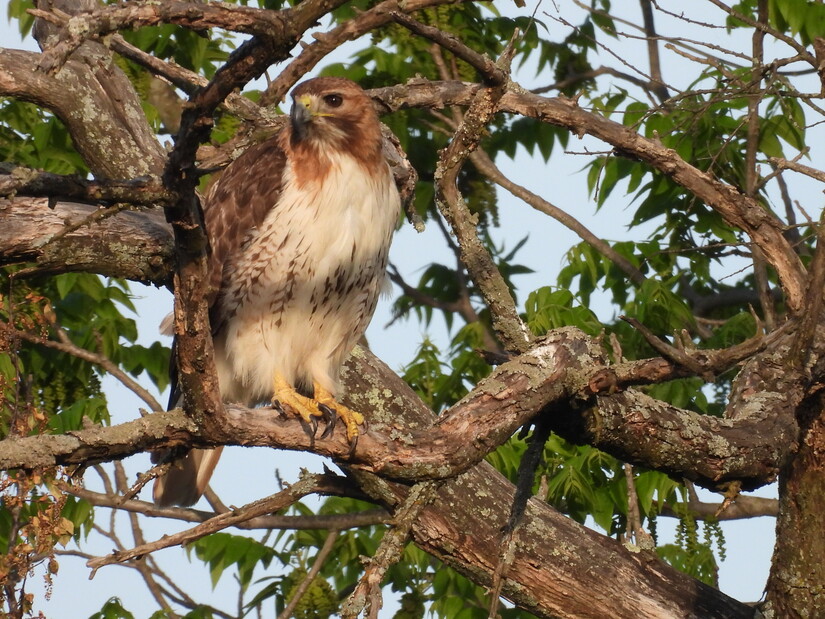Image

by Mike Strzelecki*
There are many species of hawks and falcons seen in the Boyertown area, but two of the most commonly seen are the red-tailed hawks and the red-shouldered hawks. They are known as buteo hawks. Buteos are characterized by broad bodies, rounded wings, and short tails. When perched on a branch, they are generally the size and shape of a football.
Most of the other hawks and falcon species seen in the area are leaner with sharper wing designs and longer tails. When flying overhead, these other species almost resemble a religious cross soaring in a line across the sky. On the other hand, when in flight, buteos have broad wings, fanned tails, and often soar in sweeping circles.
Red-tailed and red-shouldered hawks can be seen year-round throughout the Boyertown region. The population of red-shouldered hawks is fairly stable throughout the year since most tend to be residential species who live here year-round. The red-tailed population spikes a bit in winter because hawks of this species living to the north often come down to Pennsylvania to spend the winter before returning north in spring.
How can you tell the difference between a red-tailed and a red-shouldered hawk? There are several characteristics. Keen eyes will notice that red-tailed hawks have….wait for it…a large red tail. However this is not always obvious, especially when the hawk is perched. But when circling overhead, and if the lighting is just right, the red tail becomes obvious. In contrast, red-shouldered hawks have a black-and-white barred tail.

There is a size difference between the two buteo species, with red-tailed hawks being substantially larger than red-shouldered hawks. This is rarely a great field mark because assessing the size of a bird in the field is often a difficult task, especially when trying to compare it to the size of another bird.
There is one primary difference that birders use to differentiate between the two buteos that is more accessible to the human eye - even to untrained birders. The adult red-tailed hawk has a distinctive belly band across its underside that can be seen clearly when it is perched and facing you, and often when it is soaring. There is white plumage below the neck, then a broad swath of darker feathers, and then more white plumbage towards the bottom. The bellies of adult red-shouldered hawks have no bands - just solid reddish-orange barring across the entire belly.
The first picture below is an adult red-tailed hawk. You can clearly see the dark band across its belly highlighted by white borders. The second image is of an adult red-shouldered hawk that has solid reddish-orange barring across its chest.


It’s worth noting that juvenile buteo hawks do not reflect the same physical characteristics as adults and are often hyper-challenging to identify, even for the most skilled birders. A good hawk identification guide is recommended to tackle that challenge.
I am basing the following information on my own personal experience, though I think studies would find similar results. If you are driving down a road and see a buteo hawk perched on a lightpost or overhanging tree branch, it is probably a red-tailed hawk. This is because red-tailed hawks feed primarily on small mammals like voles, rabbits, mice, and squirrels and other critters that are plentiful in the median strips and right-of-ways of highways. The lightposts and branches present the perfect hunting platform for these hawks.
Most red-shouldered hawks I have seen were in thick woodlands or around water. This is because red-shouldered hawks also feed on crayfish, reptiles, amphibians, and insects that thrive in wetter environments. You often see them lurking around water holes or on rocks besides streams.
This is not a rule, just a general guideline, however, as red-shouldered hawks can sometimes be seen along roadways as well. As a corollary to this point, if the buteo hawk is sitting along the highway perched on an electric wire, it is probably a red-shouldered hawk as red-tailed hawks are typically too large to perch on wires.

Both species of buteo hawks are wonderful for beginning birders as they are plentiful in this region, are large enough to see with the naked eye, and are not easily spooked like so many small flitty songbirds. Last week, while hiking in a state park in Maryland, I passed a red-shouldered hawk perched at eye-level on a branch about 20 feet away (sadly, without my camera). It never even flinched as I walked by; just totally deferred the trail to me. This is why buteo hawks are always among the favorites of birders. .
* Mike Strzelecki is a freelance travel and outdoor writer, and 1981 graduate of Boyertown Area Senior High School. He writes from his house in Baltimore, Maryland. In his spare time, he joins his wife on adventures around the country observing and photographing birds.